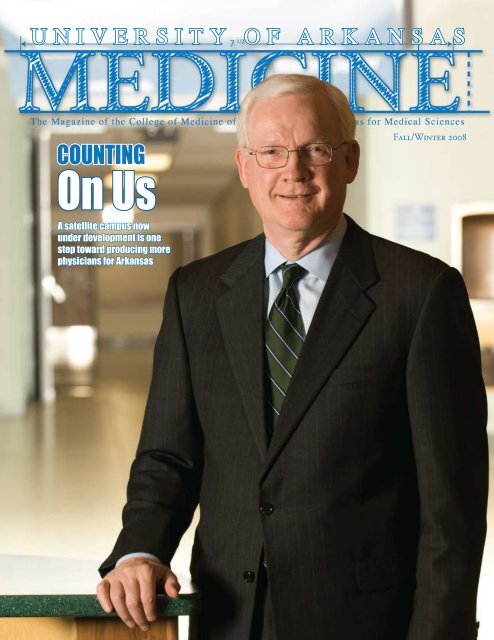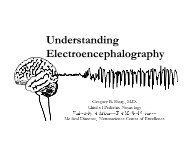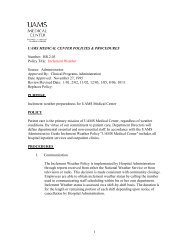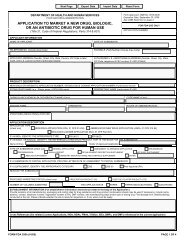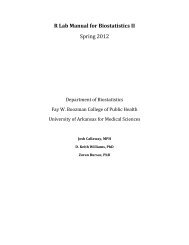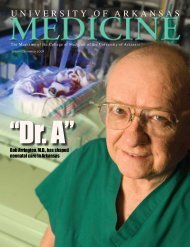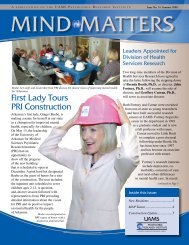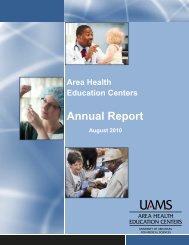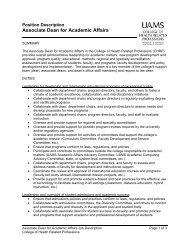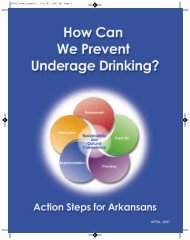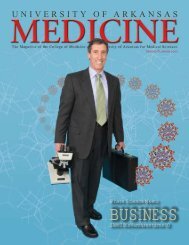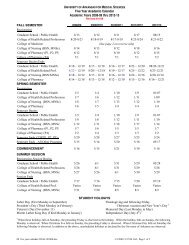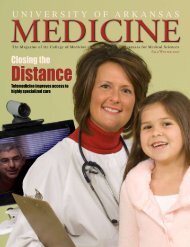Stopping the Hurt - University of Arkansas for Medical Sciences
Stopping the Hurt - University of Arkansas for Medical Sciences
Stopping the Hurt - University of Arkansas for Medical Sciences
Create successful ePaper yourself
Turn your PDF publications into a flip-book with our unique Google optimized e-Paper software.
UNIVERSITY OF ARKANSAS<br />
COUNTING<br />
On Us<br />
Fall/Winter 2008<br />
A satellite campus now<br />
under development is one<br />
step toward producing more<br />
physicians <strong>for</strong> <strong>Arkansas</strong>
I n t h e s p o t l i g h t :<br />
Page<br />
2<br />
Cover story:<br />
UAMS & <strong>the</strong> COM get ready to produce more<br />
physicians <strong>for</strong> <strong>Arkansas</strong><br />
FALL/WINTER 2008<br />
Volume 6, Issue 2<br />
News & Leaders............................................................ 14<br />
Students........................................................................ 16<br />
House Staff................................................................... 19<br />
Alumni ........................................................................ 20<br />
Looking Back................................................................ 24<br />
Page<br />
4<br />
Page<br />
6<br />
Page<br />
7<br />
Northwest Bound:<br />
Students and residents to train at satellite campus.<br />
No Time <strong>for</strong> R & R:<br />
Meet Peter Kohler.<br />
On Campus:<br />
Making room <strong>for</strong> more students.<br />
On <strong>the</strong> cover: Peter O. Kohler, M.D., a <strong>for</strong>mer College <strong>of</strong><br />
Medicine department chair and interim dean, has returned<br />
to <strong>Arkansas</strong> to head <strong>the</strong> development <strong>of</strong> a satellite campus in<br />
Northwest <strong>Arkansas</strong>. He is pictured in <strong>the</strong> lobby <strong>of</strong> <strong>the</strong> <strong>for</strong>mer<br />
Washington Regional Hospital in Fayetteville, which will be<br />
converted into a campus to help UAMS address shortfalls <strong>of</strong><br />
physicians and o<strong>the</strong>r medical pr<strong>of</strong>essionals in <strong>Arkansas</strong>. (Stories<br />
begin on page 2.)<br />
F e a t u r e s :<br />
Page<br />
8<br />
Page<br />
10<br />
<strong>Stopping</strong> <strong>the</strong> <strong>Hurt</strong>: UAMS’ Sunny<br />
Anand has made medical care <strong>for</strong> premature<br />
babies less painful.<br />
Laugh & Learn: James Pasley’s infectious<br />
personality resonates with students.<br />
Page<br />
12<br />
Team Manolagas: Endocrinologist has<br />
made UAMS a world leader in osteoporosis<br />
research.<br />
Page<br />
16<br />
Meet Our Scholars: Scholarship recipients<br />
plan to make a difference.<br />
Page<br />
18<br />
Dynamic Duo: Couple balances research,<br />
clinical training and married life.<br />
Page<br />
19<br />
A Wiki Education: How an online <strong>for</strong>um<br />
is changing academic collaboration.<br />
Page<br />
20<br />
Baghdad ER: Alumni & faculty care<br />
<strong>for</strong> <strong>the</strong> wounded.
Forward Thinking<br />
The College <strong>of</strong> Medicine’s class <strong>of</strong> 2012 has been on campus<br />
<strong>for</strong> a few months now – 160 bright, eager students starting<br />
on <strong>the</strong> path toward becoming physicians. It’s an exciting and<br />
challenging time <strong>for</strong> <strong>the</strong>m, but no less challenging than <strong>the</strong> years<br />
after <strong>the</strong>y graduate. Most <strong>of</strong> <strong>the</strong>se future physicians will care <strong>for</strong> a<br />
population that is aging and has greater health care demands.<br />
We’re working to make sure <strong>the</strong>y are well prepared <strong>for</strong> <strong>the</strong><br />
challenge – and that <strong>the</strong>re will be enough physicians in <strong>the</strong><br />
years ahead to provide all Arkansans with access to high-quality<br />
health care.<br />
The aging <strong>of</strong> America’s 79 million baby boomers – including<br />
340,000 baby boomer physicians headed <strong>for</strong> retirement –<br />
threatens to cause severe shortages <strong>of</strong> doctors as well as o<strong>the</strong>r<br />
health care pr<strong>of</strong>essionals. At <strong>the</strong> urging <strong>of</strong> <strong>the</strong> Association <strong>of</strong><br />
American <strong>Medical</strong> Colleges and o<strong>the</strong>r groups, medical schools<br />
nationwide are expanding enrollment.<br />
In this issue <strong>of</strong> <strong>University</strong> <strong>of</strong> <strong>Arkansas</strong> Medicine you’ll read about<br />
<strong>the</strong> steps we’re taking to accommodate more students. You’ll<br />
learn about <strong>the</strong> satellite campus being developed in Northwest<br />
<strong>Arkansas</strong> and about on-campus preparations such as <strong>the</strong> new<br />
education building that opened this fall. You’ll also meet Peter O.<br />
Kohler, M.D., <strong>the</strong> <strong>for</strong>mer College <strong>of</strong> Medicine interim dean who<br />
is leading <strong>the</strong> ef<strong>for</strong>t in Northwest <strong>Arkansas</strong>.<br />
Our mission as <strong>Arkansas</strong>’ only medical school has never been<br />
more important. Forward thinking, and <strong>the</strong> steps we take today,<br />
will make a great difference in <strong>the</strong> health <strong>of</strong> Arkansans <strong>for</strong> decades<br />
to come.<br />
Debra H. Fiser, M.D.<br />
Dean, College <strong>of</strong> Medicine<br />
Vice Chancellor, UAMS<br />
1<br />
UAMS COLLEGE OF MEDICINE
Counting<br />
On Us<br />
UAMS & <strong>the</strong> COM get ready to produce more physicians <strong>for</strong> <strong>Arkansas</strong><br />
For many rural Arkansans, it’s already difficult finding a<br />
physician. And national experts warn that access to physicians<br />
and o<strong>the</strong>r health care pr<strong>of</strong>essionals could be far more limited<br />
in <strong>the</strong> decades ahead.<br />
To stem <strong>the</strong> anticipated shortage <strong>of</strong> doctors, <strong>the</strong> Association<br />
<strong>of</strong> American <strong>Medical</strong> Colleges (AAMC) and o<strong>the</strong>r groups<br />
have urged medical schools to increase enrollment 30 percent<br />
by 2015.<br />
The <strong>University</strong> <strong>of</strong> <strong>Arkansas</strong> <strong>for</strong> <strong>Medical</strong> <strong>Sciences</strong> (UAMS)<br />
College <strong>of</strong> Medicine (COM) is working to ensure that<br />
<strong>Arkansas</strong> has sufficient numbers <strong>of</strong> highly trained physicians.<br />
A key step is to get more medical students into <strong>the</strong> pipeline,<br />
and <strong>the</strong> COM is planning to gradually expand <strong>the</strong> entering<br />
medical class from <strong>the</strong> current 160 students to 200.<br />
But it’s not as simple as opening <strong>the</strong> doors wider.<br />
A satellite campus is being planned in booming Northwest<br />
<strong>Arkansas</strong> to provide essential clinical training sites, preceptors<br />
and patients <strong>for</strong> third- and fourth-year medical students and<br />
residents. The Fayetteville location also will house satellite<br />
pharmacy, graduate nursing and allied health education<br />
programs. On <strong>the</strong> main campus in Little Rock, a new<br />
education building opened this fall to provide much-needed<br />
classroom and auditorium space. O<strong>the</strong>r upgrades are on <strong>the</strong><br />
drawing board, including an expansion <strong>of</strong> <strong>the</strong> Gross Anatomy<br />
Laboratory, which helps teach every COM freshman <strong>the</strong><br />
foundations <strong>of</strong> medicine.<br />
“Our citizens are counting on us,” said COM Dean and<br />
UAMS Vice Chancellor Debra H. Fiser, M.D. “As <strong>Arkansas</strong>’<br />
only medical school, we feel a sense <strong>of</strong> obligation to increase<br />
our enrollment and produce <strong>the</strong> greater number <strong>of</strong> doctors<br />
Arkansans will need in <strong>the</strong> future. It takes many years to<br />
educate and train a new physician. The time to act is now.”<br />
The looming physician shortage largely comes down to<br />
numbers. The so-called “baby boomers” – Americans born<br />
between 1946 and 1964 – have started turning 60. By 2030,<br />
<strong>the</strong> U.S. Census Bureau predicts, <strong>the</strong>re will be 72 million<br />
Americans 65 or older, twice as many as in 2000. <strong>Arkansas</strong> is<br />
graying too. With almost 14 percent <strong>of</strong> citizens over <strong>the</strong> age <strong>of</strong><br />
65, it ranks 10th in <strong>the</strong> nation. By 2030, one in five Arkansans<br />
will be at least 65 years old.<br />
“Our aging citizens will require more health care, and<br />
un<strong>for</strong>tunately <strong>Arkansas</strong> has poor health statistics to begin<br />
with,” said Fiser. <strong>Arkansas</strong> ranks in <strong>the</strong> top 10 among all<br />
states in deaths from conditions such as heart disease, cancer<br />
and stroke.<br />
Meanwhile, some 340,000 baby boomer physicians will begin<br />
retiring in just a couple <strong>of</strong> years. Experts predict that without<br />
substantial medical school enrollment increases, <strong>the</strong> nation will<br />
face an 85,000 to 200,000 physician shortfall by 2020.<br />
But <strong>Arkansas</strong> is behind <strong>the</strong> curve already. With about one<br />
doctor <strong>for</strong> every 500 citizens, <strong>Arkansas</strong> ranks near <strong>the</strong> bottom<br />
among all states and <strong>the</strong> District <strong>of</strong> Columbia in physicians<br />
per capita. All or portions <strong>of</strong> nearly two thirds <strong>of</strong> <strong>Arkansas</strong><br />
counties are federally designated primary care Health<br />
Pr<strong>of</strong>essional Shortage Areas (HPSA).<br />
The good news is that as <strong>Arkansas</strong> educates and trains more<br />
physicians, a great many <strong>of</strong> <strong>the</strong>m will remain in state to<br />
practice. Close to half <strong>of</strong> <strong>the</strong> state’s active physicians were<br />
educated or trained at UAMS, and <strong>Arkansas</strong> ranks third in <strong>the</strong><br />
nation in <strong>the</strong> percentage <strong>of</strong> active physicians who graduated<br />
from medical school in <strong>the</strong> state.<br />
Read More<br />
• UAMS expands into Northwest <strong>Arkansas</strong>....................p.4<br />
• Meet Peter Kohler ......................................................p.6<br />
• Getting <strong>the</strong> main campus ready ..................................p.7<br />
UAMS COLLEGE OF MEDICINE<br />
2<br />
3 UAMS COLLEGE OF MEDICINE
Satellite campus will accommodate more students – and inspire<br />
careers in primary care<br />
Peter Kohler, M.D., is coordinating <strong>the</strong> conversion <strong>of</strong> <strong>the</strong> <strong>for</strong>mer<br />
Washington Regional Hospital into a satellite UAMS campus.<br />
This time next year, a small group <strong>of</strong> College <strong>of</strong> Medicine (COM)<br />
juniors could be immersed in clinical training and classes some<br />
190 miles from UAMS’ Little Rock campus. If all goes well, <strong>the</strong>y’ll<br />
be <strong>the</strong> first medical students at a UAMS satellite campus.<br />
UAMS-Northwest will work with physicians and area<br />
hospitals to provide <strong>the</strong> essential clinical sites and patients that<br />
<strong>the</strong> COM needs in order to educate and train larger classes and<br />
more residents.<br />
Renovations are beginning this fall on <strong>the</strong> old Washington<br />
Regional Hospital in Fayetteville to convert it into a campus that<br />
will help UAMS address shortfalls <strong>of</strong> health care pr<strong>of</strong>essionals.<br />
At full enrollment, <strong>the</strong> campus will have more than 300 students<br />
and residents, including students in medical, pharmacy, graduate<br />
nursing and allied health programs. The UAMS Area Health<br />
Education Center (AHEC) in Fayetteville also is moving into<br />
<strong>the</strong> building.<br />
As <strong>the</strong> COM incrementally increases <strong>the</strong> freshman class from<br />
160 to 200 students, <strong>the</strong> additional students progressing through<br />
medical school each year will come to Northwest <strong>Arkansas</strong> <strong>for</strong> <strong>the</strong>ir<br />
third-year clinical rotations and fourth-year electives. The pilot<br />
group next fall likely will include about five juniors.<br />
“There is a lot to be done be<strong>for</strong>e those first students walk through<br />
<strong>the</strong> door,” said Peter O. Kohler, M.D., UAMS’ vice chancellor <strong>for</strong><br />
<strong>the</strong> Northwest <strong>Arkansas</strong> Region. “But this campus is vital to our<br />
ability to ensure access to quality health care <strong>for</strong> Arkansans in <strong>the</strong><br />
decades ahead, and we are optimistic that we can do this.”<br />
UAMS Chancellor I. Dodd Wilson, M.D., recruited Kohler to head<br />
development <strong>of</strong> <strong>the</strong> satellite campus in early 2007. (Read more about<br />
Kohler on page 6.)<br />
Why Northwest <strong>Arkansas</strong><br />
UAMS leaders studied all regions <strong>of</strong> <strong>the</strong> state to determine <strong>the</strong> best<br />
location. “The main campus and UAMS’ clinical programs around<br />
<strong>the</strong> state are close to saturated in terms <strong>of</strong> training opportunities,”<br />
Kohler said, noting that third- and fourth-year medical students<br />
must have extensive supervised contact with large numbers<br />
<strong>of</strong> patients. “Studies showed that <strong>the</strong> only area with sufficient<br />
population to support <strong>the</strong> satellite campus right now is<br />
Northwest <strong>Arkansas</strong>.”<br />
Outside <strong>of</strong> <strong>the</strong> Little Rock Metropolitan<br />
Statistical Area (MSA), <strong>the</strong> largest<br />
concentration <strong>of</strong> hospitals and health<br />
care providers is in Northwest<br />
<strong>Arkansas</strong>. And <strong>the</strong> region<br />
is growing faster than<br />
o<strong>the</strong>r areas. By 2030, <strong>the</strong><br />
Fayetteville-Springdale-Rogers<br />
MSA is expected to swell by<br />
67 percent, to more<br />
than 677,000.<br />
“This is where all <strong>of</strong> <strong>the</strong> pieces<br />
happened to fit,” said state<br />
Sen. Dave Bisbee <strong>of</strong> Rogers,<br />
who has worked with UAMS<br />
and o<strong>the</strong>rs in <strong>the</strong> region from<br />
<strong>the</strong> start and helped UAMS<br />
secure $1.9 million in seed<br />
money in 2007. “It is<br />
just so important to<br />
understand that<br />
<strong>the</strong> satellite campus will help produce doctors <strong>for</strong> <strong>the</strong> whole state.<br />
This is <strong>Arkansas</strong>’ medical school.”<br />
Building Support<br />
Bisbee, who is term-limited, won’t be in <strong>the</strong> General Assembly in<br />
early 2009 when UAMS seeks a critical ongoing appropriation<br />
to operate <strong>the</strong> new campus. But Gov. Mike Beebe has expressed<br />
support, contingent on local support and availability <strong>of</strong> state<br />
revenue, and several o<strong>the</strong>r legislators have come on board.<br />
“There certainly is a need <strong>for</strong> more physicians in <strong>the</strong> state, and that<br />
need will only increase in <strong>the</strong> years ahead,” said state Rep. Gene<br />
Shelby, M.D., who practices emergency medicine in Hot Springs<br />
and is working on a study <strong>of</strong> <strong>Arkansas</strong>’ health care work<br />
<strong>for</strong>ce needs.<br />
Cecile Bledsoe <strong>of</strong> Rogers, <strong>the</strong> senator-elect in Bisbee’s district, noted<br />
that while <strong>the</strong> health <strong>of</strong> Arkansans is ultimately what’s at stake,<br />
<strong>the</strong>re also is an economic component <strong>for</strong> communities. “When<br />
newcomers and businesses consider locating in an area, <strong>the</strong>y do<br />
evaluate <strong>the</strong> community’s health care opportunities,” she said.<br />
Kohler and o<strong>the</strong>rs have been working to raise philanthropic<br />
contributions <strong>for</strong> <strong>the</strong> renovations to <strong>the</strong> <strong>for</strong>mer Washington<br />
Regional building – and to demonstrate local support. Nearly $2<br />
million has been pledged, including a $100,000 donation from <strong>the</strong><br />
Northwest <strong>Arkansas</strong> Community Foundation, $300,000 from <strong>the</strong><br />
Walton Family Foundation on <strong>the</strong> recommendation <strong>of</strong> <strong>the</strong> nine<br />
Arvest Bank presidents in <strong>Arkansas</strong>, and $500,000 from<br />
Care Foundation, Inc.<br />
Washington County has leased <strong>the</strong> property to <strong>the</strong> state <strong>for</strong> $1<br />
a year, saving millions <strong>of</strong> dollars in lease or construction costs.<br />
The 330,000-square-foot main building will house classrooms,<br />
simulation labs, a library, administrative <strong>of</strong>fices and <strong>the</strong> AHEC<br />
clinics. Videoconferencing systems will facilitate distance learning<br />
with <strong>the</strong> main campus.<br />
Promoting Primary Care<br />
<strong>Medical</strong> students at UAMS-Northwest won’t just be in a new<br />
location. They’ll be <strong>the</strong> first in <strong>Arkansas</strong> to experience clinical<br />
clerkships in a new way.<br />
“We want to make sure all Arkansans have access to care, and that<br />
means producing graduates who want to work as first-contact,<br />
primary care physicians,” said Richard P. Wheeler, M.D., <strong>the</strong> COM’s<br />
executive associate dean <strong>for</strong> academic affairs.<br />
Juniors at <strong>the</strong> satellite will complete <strong>the</strong> same clerkships as <strong>the</strong>ir<br />
classmates in Little Rock, but <strong>the</strong>y won’t rotate through traditional<br />
multi-week blocks devoted to individual disciplines. Instead,<br />
students will experience all <strong>of</strong> <strong>the</strong> facets <strong>of</strong> medicine on an ongoing<br />
basis. Following a “longitudinal” curriculum, <strong>the</strong>y might work in a<br />
family medicine clinic one day, with a psychiatrist <strong>the</strong> next, and with<br />
a surgeon ano<strong>the</strong>r day <strong>of</strong> <strong>the</strong> week, Wheeler said.<br />
“The experience will be a little more like <strong>the</strong>y would have as primary<br />
care physicians, whose patients and cases are different each day,”<br />
added Kohler. “We think it will appeal to a lot <strong>of</strong> students.”<br />
Longitudinal curricula are being advocated by a national consortium<br />
<strong>of</strong> schools. The curriculum is a good fit <strong>for</strong> UAMS-Northwest,<br />
where most <strong>of</strong> <strong>the</strong> faculty serving as preceptors will be physicians in<br />
area clinics and hospitals. Participating physicians won’t necessarily<br />
have to devote <strong>the</strong> multiple consecutive weeks <strong>of</strong> time that would be<br />
needed with block scheduling.<br />
UAMS COLLEGE OF MEDICINE<br />
4<br />
5 UAMS COLLEGE OF MEDICINE
Finding Faculty<br />
Recruiting faculty is one <strong>of</strong> many logistical steps <strong>for</strong> Kohler and his<br />
staff. The need <strong>for</strong> preceptors will grow as <strong>the</strong> number <strong>of</strong> medical<br />
students and residents increases. “Physicians in private practice have<br />
much to <strong>of</strong>fer as educators,” Kohler said. “They provide students<br />
with practical experience, and at <strong>the</strong> same time <strong>the</strong>y usually feel that<br />
<strong>the</strong> students bring something very positive to <strong>the</strong> clinic.”<br />
Rogers pediatrician Marti Sharkey, M.D., is thrilled at <strong>the</strong><br />
opportunity. The Fayetteville native was born in <strong>the</strong> old Washington<br />
Regional Hospital. While in residency at Johns Hopkins <strong>University</strong><br />
in Baltimore, she trained to teach o<strong>the</strong>rs. “I am very excited about<br />
<strong>the</strong> opportunity to share my love <strong>of</strong> medicine and pediatrics with<br />
physicians in training,” she said.<br />
Peter Kohler, M.D., is never without his Blackberry.<br />
A long and successful career in academic medicine took<br />
Peter O. Kohler, M.D., from one coast to <strong>the</strong> o<strong>the</strong>r, but<br />
grandchildren and fond memories brought him back to<br />
<strong>Arkansas</strong> when he retired.<br />
But “retirement” isn’t all rest and relaxation <strong>for</strong> Kohler. The<br />
<strong>for</strong>mer department chairman and interim dean <strong>of</strong> <strong>the</strong> College <strong>of</strong><br />
Medicine is leading UAMS’ ef<strong>for</strong>t to open a satellite campus in<br />
Northwest <strong>Arkansas</strong>.<br />
“I would not be good just hanging around <strong>the</strong> house, or as<br />
my wife says, hanging on <strong>the</strong> refrigerator door,” said Kohler,<br />
who was appointed vice chancellor <strong>for</strong> <strong>the</strong> Northwest <strong>Arkansas</strong><br />
Region by UAMS Chancellor I. Dodd Wilson in April 2007.<br />
“It is vital <strong>for</strong> <strong>Arkansas</strong> to get more future physicians and health<br />
care pr<strong>of</strong>essionals into <strong>the</strong> pipeline,” Kohler said. “So <strong>for</strong> me,<br />
this is an exciting opportunity to do something worthwhile.”<br />
“Dr. Kohler brings a passion <strong>for</strong> academic medicine and an<br />
exemplary record <strong>of</strong> success to our ef<strong>for</strong>t,” said Wilson. “This is<br />
a complex and extremely important project, and he is <strong>the</strong> very<br />
best person to have at <strong>the</strong> helm.”<br />
No Time<br />
<strong>for</strong> R & R<br />
Continued from page 5<br />
The feeling is similar <strong>for</strong> Fayetteville ophthalmologist Morriss<br />
Henry, M.D., who has welcomed many visiting UAMS students<br />
and residents into his clinic. “It’s nice to pass along <strong>the</strong> knowledge<br />
that someone gave you, along with your own experiences,” he said.<br />
“As a preceptor you really have to stay abreast because students ask a<br />
lot <strong>of</strong> questions. It keeps you fresh.”<br />
Henry has become an ambassador <strong>for</strong> <strong>the</strong> satellite as chairman <strong>of</strong><br />
<strong>the</strong> UAMS-Northwest Advisory Board, a panel <strong>of</strong> 16 health care,<br />
business and education leaders in <strong>the</strong> region. “I really see this<br />
campus as a golden opportunity to improve health care throughout<br />
<strong>Arkansas</strong>,” he said. “I want to make sure people understand <strong>the</strong><br />
importance <strong>of</strong> this.”<br />
Meet Peter O. Kohler, M.D.<br />
Kohler graduated from Duke <strong>University</strong> School <strong>of</strong> Medicine<br />
in 1963 and worked as a researcher <strong>for</strong> several years at <strong>the</strong><br />
National Cancer Institute in Be<strong>the</strong>sda, Md. From <strong>the</strong>re it was<br />
on to <strong>the</strong> Baylor College <strong>of</strong> Medicine, where he was chief <strong>of</strong><br />
<strong>the</strong> Endocrinology Division from 1973 to 1977, when he was<br />
recruited to UAMS. He was chairman <strong>of</strong> <strong>the</strong> Department <strong>of</strong><br />
Internal Medicine <strong>for</strong> nine years and served as interim dean in<br />
1985-1986.<br />
Kohler left <strong>Arkansas</strong> to become dean <strong>of</strong> <strong>the</strong> <strong>University</strong> <strong>of</strong> Texas<br />
Health Science Center in San Antonio. In 1988 he was recruited<br />
to <strong>the</strong> Oregon Health & Science <strong>University</strong> (OHSU) in<br />
Portland, where he oversaw tremendous growth during 18 years<br />
as president. At his retirement, he was one <strong>of</strong> <strong>the</strong> longest serving<br />
presidents at a U.S. academic medical center.<br />
“I would not be good just<br />
hanging around <strong>the</strong> house, or<br />
as my wife says, hanging on <strong>the</strong><br />
refrigerator door,” Kohler said.<br />
More College <strong>of</strong> Medicine (COM) freshmen and<br />
sophomores will be on campus in <strong>the</strong> years ahead, and<br />
UAMS is making sure <strong>the</strong>y’ll have <strong>the</strong> classrooms, labs<br />
and o<strong>the</strong>r resources <strong>the</strong>y need to learn <strong>the</strong> fundamentals<br />
<strong>of</strong> medicine.<br />
New Education Building<br />
The I. Dodd Wilson Education building opened this fall,<br />
adding 14 classrooms that seat 24, two 40-seat classrooms<br />
and two 219-seat auditoriums. The 44,300-square-foot,<br />
two-story building is located west <strong>of</strong> Hooper Drive. A<br />
pedestrian bridge over Hooper connects <strong>the</strong> new building<br />
to <strong>the</strong> College <strong>of</strong> Public Health.<br />
The building is essential to <strong>the</strong> COM’s plans to expand<br />
enrollment from <strong>the</strong> current class <strong>of</strong> 160 students to 200<br />
students. Previously, <strong>the</strong>re was no teaching auditorium<br />
large enough to seat a class <strong>of</strong> 200. The building’s smaller<br />
rooms will support <strong>the</strong> COM’s increasing use <strong>of</strong> smallgroup<br />
teaching sessions.<br />
The state-<strong>of</strong>-<strong>the</strong>-art building features electrical outlets<br />
<strong>for</strong> laptops at each seat and wireless internet access.<br />
Videoconferencing systems will enable distance education<br />
with o<strong>the</strong>r locations, including <strong>the</strong> new satellite<br />
campus in Fayetteville. The $15.2 million building was<br />
funded mostly through a 2006 bond issue approved<br />
by <strong>Arkansas</strong> voters. It was named in honor <strong>of</strong> retiring<br />
UAMS Chancellor I. Dodd Wilson, M.D., at an Oct. 22<br />
dedication ceremony.<br />
Gross Anatomy Expansion<br />
All COM freshmen – in what <strong>the</strong>y generally consider one<br />
<strong>of</strong> <strong>the</strong>ir most important experiences – learn <strong>the</strong> intricacies<br />
<strong>of</strong> <strong>the</strong> human body through dissection <strong>of</strong> cadavers in <strong>the</strong><br />
Gross Anatomy Laboratory.<br />
Campus Projects<br />
Make Room <strong>for</strong><br />
More Students<br />
But <strong>the</strong> 6,850-square-foot lab is at capacity, making enrollment<br />
increases impossible without expanding <strong>the</strong> facility. Plans are to<br />
reconfigure <strong>the</strong> space and purchase 10 more dissection tables,<br />
equipment, computers, models and o<strong>the</strong>r resources to support 40<br />
additional students.<br />
The COM is seeking philanthropic funding <strong>for</strong> <strong>the</strong> $2.3 million<br />
expansion, which is slated <strong>for</strong> 2009. Among <strong>the</strong> fundraisers <strong>for</strong><br />
<strong>the</strong> project is a naming campaign. The overall facility and various<br />
components can be named in honor or memory <strong>of</strong> educators,<br />
donors or o<strong>the</strong>rs.<br />
For more in<strong>for</strong>mation about <strong>the</strong> fundraising campaign, please contact<br />
Brooke Ivy, associate director <strong>of</strong> development, at (501) 686-7203, or by<br />
e-mail: BIvy@uams.edu.<br />
Freshman Caryn Taylor<br />
attends classes in <strong>the</strong><br />
new I. Dodd Wilson<br />
Education Building<br />
(shown above).<br />
UAMS COLLEGE OF MEDICINE 6<br />
7 UAMS COLLEGE OF MEDICINE
<strong>Stopping</strong><br />
<strong>the</strong> <strong>Hurt</strong><br />
UAMS’ Sunny Anand<br />
has made medical care<br />
<strong>for</strong> premature babies<br />
less painful<br />
Kanwaljeet S. “Sunny” Anand, M.B.B.S., D. Phil., is happiest<br />
when he’s in <strong>the</strong> pediatric intensive care unit, caring <strong>for</strong> <strong>Arkansas</strong>’<br />
infants and children. But he also finds fulfillment in <strong>the</strong> laboratory,<br />
where <strong>for</strong> <strong>the</strong> past 25 years he has changed how physicians<br />
worldwide view and manage pain in babies.<br />
“My favorite place is at <strong>the</strong> bedside, taking care <strong>of</strong> children and<br />
talking to families,” said Anand, a pr<strong>of</strong>essor <strong>of</strong> pediatrics, anes<strong>the</strong>siology,<br />
pharmacology and neurobiology in <strong>the</strong> UAMS College<br />
<strong>of</strong> Medicine and director <strong>of</strong> <strong>the</strong> Pain Neurobiology Laboratory at<br />
<strong>Arkansas</strong> Children’s Hospital Research Institute (ACHRI). “Clinical<br />
care and interacting with families motivates me to go back to<br />
<strong>the</strong> lab and try harder.”<br />
Anand’s determination was sparked by a crucial observation when<br />
he was a pediatric resident and research fellow in England in 1982.<br />
He was in Ox<strong>for</strong>d on a Rhodes Scholarship after completing<br />
medical school and training in India. Working in a neonatal<br />
intensive care unit, he <strong>of</strong>ten saw his patients leave <strong>for</strong> surgery in<br />
relatively good shape, only to return highly unstable. “They would<br />
come back looking gray and in shock,” he recalled.<br />
Anand learned that babies were not receiving anes<strong>the</strong>sia <strong>for</strong> major<br />
operations. It was standard practice at <strong>the</strong> time, because physicians<br />
believed that neonates’ nervous systems weren’t developed enough<br />
to feel pain, and that anes<strong>the</strong>sia could harm <strong>the</strong>m.<br />
Anand convinced his doctoral supervisor to let him study <strong>the</strong><br />
effects <strong>of</strong> pain and anes<strong>the</strong>sia by measuring hormonal and<br />
metabolic changes during and after surgery. “We found that babies<br />
had hormonal stress responses three to five times greater than that<br />
<strong>of</strong> adults,” he said. “But when we gave babies anes<strong>the</strong>sia, <strong>the</strong>ir stress<br />
responses came down, metabolic changes normalized and <strong>the</strong>y had<br />
fewer complications. This was completely uncharted territory at<br />
<strong>the</strong> time.”<br />
Anand continued his studies during a postdoctoral fellowship at<br />
Harvard <strong>University</strong> and Boston Children’s Hospital. His discovery<br />
that higher doses <strong>of</strong> anes<strong>the</strong>sia significantly reduced mortality was<br />
published as a lead article in <strong>the</strong> New England Journal <strong>of</strong> Medicine<br />
in 1992. O<strong>the</strong>r studies explored “what this means” – how stress<br />
responses and o<strong>the</strong>r indicators reflected that babies may actually<br />
feel pain.<br />
“It was almost like a silent revolution started from Boston,” said<br />
Anand. Within a few years, hundreds <strong>of</strong> studies were being done<br />
on pain in neonates and children, and in various diseases and<br />
procedures. “For <strong>the</strong> first time, people realized that if you have a<br />
kinder, gentler approach to babies, it will improve <strong>the</strong>ir outcomes,”<br />
he said.<br />
By <strong>the</strong>n, Anand had come to a personal crossroads. Despite his<br />
training in India and England and growing prominence in pain<br />
research, becoming a licensed physician in <strong>the</strong> United States<br />
required starting over as an intern. “I could not imagine myself not<br />
being a physician,” said Anand. He completed an internship and<br />
residency in pediatrics at Boston Children’s Hospital and fellowship<br />
training in neonatal and pediatric intensive care at Massachusetts<br />
General Hospital.<br />
Anand joined <strong>the</strong> faculty <strong>of</strong> Emory <strong>University</strong> in Atlanta in 1993<br />
and began studying <strong>the</strong> long-term effects <strong>of</strong> repetitive pain in<br />
neonates. Through animal studies he learned that repeated needle<br />
sticks during <strong>the</strong> first week <strong>of</strong> life led to altered pain processing,<br />
higher anxiety, greater preference <strong>for</strong> alcohol and altered social<br />
discrimination in adulthood.<br />
In 1997, <strong>the</strong>n Pediatrics Chair Debra H. Fiser, now <strong>the</strong> College <strong>of</strong><br />
Medicine dean, recruited Anand to UAMS. He developed an active<br />
laboratory at ACHRI and served as chief <strong>of</strong> Critical Care Medicine<br />
until 2003. Since 2001 he has held <strong>the</strong> Morris & Hettie Oakley<br />
Endowed Chair in Pediatric Critical Care Medicine.<br />
Anand’s research has continued on many fronts. One <strong>of</strong> his earliest<br />
projects at UAMS was to lead a multi-center, federally-funded<br />
study <strong>of</strong> <strong>the</strong> effects <strong>of</strong> morphine used <strong>for</strong> pain relief in premature<br />
babies. Anand and colleagues reported in The Lancet in 2004 that<br />
routine doses <strong>of</strong> morphine did not prevent <strong>the</strong> brain injuries leading<br />
to cerebral palsy in premature infants. The National Institutes<br />
<strong>of</strong> Health recently approved funding <strong>for</strong> a follow-up study <strong>of</strong> <strong>the</strong><br />
long-term cognitive, behavioral and physical effects <strong>of</strong> morphine<br />
in babies from <strong>the</strong> original study. The lab also is exploring safer<br />
pain medications including non-pharmacological methods such as<br />
acupuncture.<br />
Among many national roles, Anand served as chairman <strong>of</strong> <strong>the</strong><br />
Neonatal Pain Task Force <strong>for</strong> <strong>the</strong> Newborn Drug Development<br />
Initiative coordinated by <strong>the</strong> U.S. Food and Drug Administration<br />
and <strong>the</strong> National Institute <strong>of</strong> Child Health and Human Development<br />
in 2003-2006. He currently is a member <strong>of</strong> <strong>the</strong> FDA’s<br />
Anes<strong>the</strong>sia and Life Support Drugs Advisory Committee and <strong>the</strong><br />
American Board <strong>of</strong> Pediatrics.<br />
Anand has earned accolades in <strong>Arkansas</strong> and around <strong>the</strong> globe. In<br />
April he will travel to Uppsala, Sweden, to receive one <strong>of</strong> <strong>the</strong> most<br />
prestigious awards in pediatrics, <strong>the</strong> Nils Rosén von Rosenstein<br />
Medal. The award, presented to three physicians every five years<br />
by <strong>the</strong> Swedish Pediatric Society, is named after <strong>the</strong> 18th century<br />
physician considered to be <strong>the</strong> founder <strong>of</strong> modern pediatrics.<br />
Four prominent U.S. physicians have received <strong>the</strong> medal since<br />
its inception in 1964, including C. Henry Kempe, a pioneer in<br />
<strong>the</strong> prevention and treatment <strong>of</strong> smallpox and early leader in <strong>the</strong><br />
detection and prevention <strong>of</strong> child abuse.<br />
UAMS COLLEGE OF MEDICINE<br />
8<br />
9<br />
UAMS COLLEGE OF MEDICINE
James Pasley, Ph.D., has been<br />
entertaining and educating students<br />
with memorable skits <strong>for</strong> 38 years.<br />
James Pasley’s infectious personality<br />
resonates with students<br />
As <strong>the</strong> “king <strong>of</strong> double entendres,” James Pasley, Ph.D., sees<br />
his students as gluttons <strong>for</strong> punishment. He has taught<br />
physiology to College <strong>of</strong> Medicine freshmen <strong>for</strong> 38<br />
years, blending his infectious personality with<br />
comedy. It might just be <strong>the</strong> humor injected<br />
into every lecture or his legendary portrayal <strong>of</strong><br />
a contracting colon that allows students to<br />
retain tough material.<br />
“That’s just me!” Pasley said. “I enjoy humor and<br />
getting a little ping in. I use a lot <strong>of</strong> puns, which I<br />
know is <strong>the</strong> lowest <strong>for</strong>m <strong>of</strong> humor, but <strong>the</strong>y are so bad<br />
that <strong>the</strong> students have to remember <strong>the</strong> material!”<br />
A nationally recognized medical educator, Pasley is a pr<strong>of</strong>essor in<br />
<strong>the</strong> Department <strong>of</strong> Physiology and Biophysics and associate dean<br />
<strong>for</strong> educational advancement. He has received <strong>the</strong> Chancellor’s<br />
Faculty Teaching Award, <strong>the</strong> Master Teacher Award and<br />
numerous Red Sash Awards. He also held <strong>the</strong> Lutterloh <strong>Medical</strong><br />
Education Excellence Pr<strong>of</strong>essorship. He sees his role as helping<br />
students focus on <strong>the</strong>ir own goal <strong>of</strong> doing well in medical school<br />
so that <strong>the</strong>y can have a great, successful career not only helping<br />
patients but <strong>the</strong>ir communities as well.<br />
“In addition to his memorable lectures, I’ve had wonderful<br />
personal experiences talking to him and just shooting <strong>the</strong> breeze,”<br />
said James Pruitt, a third – year medical student. “He’s always<br />
been supportive <strong>of</strong> what I do.”<br />
Pasley has helped implement numerous student preparation<br />
programs that all emphasize <strong>the</strong> critical thinking skills needed to<br />
succeed in medical school. He teaches <strong>the</strong> thirteen-week MCAT<br />
prep course <strong>for</strong> college juniors and seniors, and directs a Step 1<br />
and Step 2 exam review <strong>for</strong> current medical students. Students<br />
work on questions in small groups to build <strong>the</strong>ir test taking skills<br />
through <strong>the</strong> courses.<br />
“The amount <strong>of</strong> in<strong>for</strong>mation that medical students are exposed<br />
to, which grows every year, is like trying to drink out <strong>of</strong> a fire<br />
hose,” he said. “It’s just so much. What we tell students is it’s not<br />
just how much you know, it’s how well you use your knowledge.<br />
We emphasize that students must learn to problem solve and<br />
to apply <strong>the</strong>ir in<strong>for</strong>mation to a different situation <strong>the</strong>y’ve never<br />
heard <strong>of</strong>.”<br />
In<br />
1993,<br />
Pasley<br />
noticed<br />
that many<br />
students had<br />
difficulty adjusting<br />
to <strong>the</strong> first semester <strong>of</strong><br />
medical school. “Instead <strong>of</strong><br />
letting <strong>the</strong> students spend <strong>the</strong>ir<br />
time trying to crawl out <strong>of</strong> that<br />
hole and get back with <strong>the</strong> rest <strong>of</strong><br />
<strong>the</strong> class or not make it at all, I<br />
felt that if we could start some<br />
kind <strong>of</strong> an early intervention<br />
plan, it would give <strong>the</strong>m a<br />
jump start,” he said.<br />
The Pre-Matriculation Program<br />
is indeed a head start – an<br />
academic and social acclimation<br />
to medical school. Students<br />
choosing to enroll in this voluntary<br />
program start <strong>the</strong> summer be<strong>for</strong>e <strong>the</strong>ir<br />
first year and begin some <strong>of</strong> <strong>the</strong>ir courses<br />
early, sample <strong>the</strong> entire curriculum, learn about<br />
future residency opportunities and meet a group <strong>of</strong><br />
peers who will be with <strong>the</strong>m <strong>for</strong> <strong>the</strong> next four years.<br />
“It’s a jump start to medical school so <strong>the</strong>y will hit <strong>the</strong> ground<br />
running from <strong>the</strong> beginning, and that’s what we want <strong>the</strong>m<br />
to do,” Pasley said. “The students <strong>the</strong>n have a built-in support<br />
group from <strong>the</strong> program, and I think that’s one <strong>of</strong> <strong>the</strong> great<br />
strengths. They can rely on each o<strong>the</strong>r all four years.” A record<br />
number <strong>of</strong> 44 students “graduated” from <strong>the</strong> 2008 program –<br />
more than a quarter <strong>of</strong> <strong>the</strong> freshman class.<br />
“After 16 years <strong>of</strong> <strong>the</strong> program, we think we are on <strong>the</strong> right<br />
track in helping <strong>the</strong>se students acclimate to medical school,”<br />
Pasley said. “That’s what has been so satisfying to me, if I can be<br />
<strong>of</strong> some help. The students actually do <strong>the</strong> work, not me. But if<br />
we can help <strong>the</strong>m in some way to be able to use <strong>the</strong> skills and<br />
knowledge <strong>the</strong>y already have to do well, <strong>the</strong>n I’m pleased. I’m<br />
happy to play some small role in that.”<br />
UAMS COLLEGE OF MEDICINE<br />
10<br />
11<br />
UAMS COLLEGE OF MEDICINE
Stavros Manolagas, M.D., Ph.D., (center) fosters friendly<br />
competition among colleagues - even hosting an annual water<br />
volleyball game. Joining him in <strong>the</strong> pool are (from left) Bob<br />
Jilka, Ph.D., Charles O’Brien, Ph.D., Maria Schuller, Ph.D.,<br />
and Carlos Galli, Ph.D., D.D.S.<br />
If you ask <strong>the</strong> College <strong>of</strong> Medicine’s Stavros Manolagas, M.D.,<br />
Ph.D., about his three decades <strong>of</strong> work in osteoporosis and bone<br />
metabolism research, sports aphorisms are likely to spring <strong>for</strong>th.<br />
They frame discussion <strong>of</strong> how he recruited an international<br />
team <strong>of</strong> researchers to <strong>the</strong> UAMS Center <strong>for</strong> Osteoporosis and<br />
Metabolic Bone Diseases. “We had a good idea and a supportive<br />
school,” Manolagas said. “It was <strong>the</strong> concept <strong>of</strong> ‘build it and <strong>the</strong>y<br />
will come.’ And like a baseball team, we’ve recruited ‘hitters’ and<br />
‘pitchers’ whose strengths complement one ano<strong>the</strong>r.”<br />
The Division <strong>of</strong> Endocrinology director has a coach-like management<br />
philosophy. “I’m a strong believer that if you push <strong>for</strong><br />
excellence, you’re going to get it,” he said. “But you have to be<br />
demanding and you have to motivate people. You have to raise<br />
<strong>the</strong> bar.”<br />
Sports references even crop up in Manolagas’ publications, such<br />
as an editorial in <strong>the</strong> July issue <strong>of</strong> Endocrinology titled: “De-fense!<br />
De-fense! De-fense: Scavenging H2O2 While Making Cholesterol.”<br />
But colleagues say <strong>the</strong> adages are a good fit. “Dr. Manolagas is very<br />
demanding,” said Internal Medicine Chairman James Marsh, M.D.<br />
“But his faculty respect that and <strong>the</strong>y love him. He truly gets <strong>the</strong><br />
very best out <strong>of</strong> his team.”<br />
Manolagas is <strong>the</strong> Thomas A. Andreoli, M.D., M.A.C.P., Clinical<br />
Scholar Chair in Internal Medicine, named <strong>for</strong> <strong>the</strong> <strong>for</strong>mer<br />
department chairman who recruited him to UAMS 15 years ago.<br />
Manolagas also is a pr<strong>of</strong>essor and vice chair <strong>for</strong> research in<br />
<strong>the</strong> department.<br />
Born in Piraeus, Greece, Manolagas received his medical degree at<br />
<strong>the</strong> <strong>University</strong> <strong>of</strong> A<strong>the</strong>ns in 1969. He completed his clinical training<br />
in Manchester, England, as well as a research fellowship that<br />
culminated in a doctoral degree in biochemistry and endocrinology.<br />
He immigrated to <strong>the</strong> United States in 1979 to join <strong>the</strong> faculty<br />
<strong>of</strong> <strong>the</strong> <strong>University</strong> <strong>of</strong> Cali<strong>for</strong>nia at San Diego. He spent 10 years<br />
in Cali<strong>for</strong>nia and <strong>the</strong>n six years at Indiana <strong>University</strong>, becoming<br />
prominent in <strong>the</strong> field <strong>of</strong> osteoporosis and bone metabolism.<br />
“What I saw was an individual who was driven to achieve in <strong>the</strong><br />
best sense <strong>of</strong> <strong>the</strong> word,” said Andreoli, who is now a distinguished<br />
pr<strong>of</strong>essor <strong>of</strong> medicine at UAMS. “Dr. Manolagas was already well<br />
known, which gave him a strong hand in recruiting, and he was a<br />
gifted investigator.”<br />
In 1993 <strong>the</strong> division had only $50,000 in research funds and five<br />
faculty members. Today <strong>the</strong> division’s annual research budget is<br />
more than $5 million, and <strong>the</strong> faculty has grown to about 30.<br />
The Center <strong>for</strong> Osteoporosis and Metabolic Bone Diseases, which<br />
Manolagas founded, pools <strong>the</strong> expertise <strong>of</strong> researchers from across<br />
campus. One <strong>of</strong> <strong>the</strong> largest osteoporosis research centers in <strong>the</strong><br />
world, it has brought in some $50 million, including continuous<br />
program funding <strong>for</strong> over a decade from <strong>the</strong> National Institutes<br />
<strong>of</strong> Health.<br />
The center has greatly expanded understanding <strong>of</strong> bone biology<br />
and <strong>the</strong> molecular and cellular mechanisms <strong>of</strong> osteoporosis. In<br />
1999, with <strong>the</strong> help <strong>of</strong> UAMS BioVentures, Manolagas founded a<br />
startup company to develop treatments <strong>for</strong> bone loss. Anabonix,<br />
Inc. initially focused on estren, a syn<strong>the</strong>tic compound that reversed<br />
bone loss in animal studies while avoiding <strong>the</strong> health risks <strong>of</strong><br />
conventional hormone replacement <strong>the</strong>rapies. Manolagas’ findings,<br />
published in Science, drew international news coverage. The<br />
company, now called Radius Health, Inc. and based in Cambridge,<br />
Mass., is developing a new generation <strong>of</strong> drug <strong>the</strong>rapies <strong>for</strong><br />
osteoporosis and o<strong>the</strong>r conditions. Manolagas serves on <strong>the</strong><br />
scientific advisory board.<br />
When Manolagas came to UAMS, he was allocated <strong>the</strong> eighth floor<br />
<strong>of</strong> what is now <strong>the</strong> Winthrop P. Rockefeller Cancer Institute. To<br />
facilitate dialogue and collaboration, he had windows installed between<br />
labs and <strong>the</strong> corridor. “Our floor was designed to encourage<br />
synergy and interaction among <strong>the</strong> researchers,” he said. “Scientists<br />
must communicate. The middle <strong>of</strong> our floor has a library, and we<br />
view it as sort <strong>of</strong> a village square <strong>for</strong> ideas.”<br />
In recent years, <strong>the</strong> team’s idea-sharing has contributed to a broader<br />
approach to osteoporosis research focusing on links to oxidative<br />
stress. “The same mechanisms seem to be responsible <strong>for</strong> many<br />
diseases <strong>of</strong> old age,” Manolagas said. “The mechanism that we<br />
found <strong>for</strong> osteoporosis seems to be very similar to mechanisms that<br />
o<strong>the</strong>r researchers have found <strong>for</strong> insulin resistance and diabetes,<br />
hyperlipidemia and a<strong>the</strong>rosclerosis. We could actually be moving<br />
toward having not one drug <strong>for</strong> one disease, but one drug <strong>for</strong> many<br />
diseases. So that is very, very exciting.”<br />
“Dr. Manolagas is very<br />
demanding,” said Internal<br />
Medicine Chairman James<br />
Marsh, M.D. “But his faculty<br />
respect that and <strong>the</strong>y love him.<br />
He truly gets <strong>the</strong> very best out<br />
<strong>of</strong> his team.”<br />
UAMS COLLEGE OF MEDICINE<br />
12<br />
13 UAMS COLLEGE OF MEDICINE
News & Leaders<br />
UAMS and Partners to Provide Inpatient Mental Health Care in Northwest <strong>Arkansas</strong><br />
The <strong>University</strong> <strong>of</strong><br />
<strong>Arkansas</strong> <strong>for</strong> <strong>Medical</strong><br />
<strong>Sciences</strong> (UAMS)<br />
Psychiatric Research<br />
Institute (PRI)<br />
and a coalition <strong>of</strong><br />
community providers<br />
have partnered to<br />
establish a muchneeded<br />
inpatient<br />
mental health unit in<br />
Northwest <strong>Arkansas</strong>.<br />
The PRI will provide patient care and oversight <strong>of</strong> <strong>the</strong> 29-bed<br />
inpatient program slated to open in January at Northwest<br />
<strong>Medical</strong> Center-Springdale. PRI also is developing an<br />
COM Announces New<br />
In<strong>for</strong>matics Division<br />
The College <strong>of</strong> Medicine (COM) is<br />
developing a biomedical in<strong>for</strong>matics<br />
program that will provide technology,<br />
computer systems and expertise to help<br />
researchers and clinicians manage <strong>the</strong><br />
massive amount <strong>of</strong> data that is being<br />
generated and efficiently translate findings<br />
into better medicine.<br />
As part <strong>of</strong> <strong>the</strong> initiative, <strong>the</strong> COM is<br />
establishing a Division <strong>of</strong> In<strong>for</strong>matics in<br />
<strong>the</strong> Department <strong>of</strong> Biostatistics and has<br />
begun a national search <strong>for</strong> a director.<br />
COM leaders are working to secure<br />
philanthropic and o<strong>the</strong>r funding <strong>for</strong> <strong>the</strong><br />
initiative. Dean Debra H. Fiser, M.D.,<br />
has allocated this year’s proceeds from<br />
<strong>the</strong> Dean’s Society, an annual giving<br />
organization, to help launch <strong>the</strong> division.<br />
“Many medical breakthroughs could be<br />
right under our noses,” said Lawrence<br />
Cornett, Ph.D., executive associate<br />
dean <strong>for</strong> research in <strong>the</strong> COM and<br />
vice chancellor <strong>for</strong> research at UAMS.<br />
“The challenge is to pull toge<strong>the</strong>r vast<br />
amounts <strong>of</strong> very different types <strong>of</strong> genetic,<br />
pharmaceutical and o<strong>the</strong>r in<strong>for</strong>mation,<br />
and our in<strong>for</strong>matics initiative will help us<br />
to do that.”<br />
outpatient clinic to serve pre- and post-admission needs <strong>of</strong> some<br />
patients, and <strong>the</strong> program will be used as a teaching site <strong>for</strong><br />
UAMS psychiatry residency and fellowship programs.<br />
The late 1990s and early 2000s saw a number <strong>of</strong> inpatient<br />
psychiatry programs close throughout <strong>Arkansas</strong>. The Northwest<br />
<strong>Arkansas</strong> region has been without an inpatient mental health<br />
unit since early 2002.<br />
In addition to UAMS and Northwest Health System, <strong>the</strong><br />
coalition includes Ozark Guidance, <strong>the</strong> Care Foundation,<br />
Washington Regional <strong>Medical</strong> Center and Mercy Health System<br />
<strong>of</strong> Northwest <strong>Arkansas</strong>. The project is being funded with more<br />
than $1 million in special funds from <strong>the</strong> governor’s <strong>of</strong>fice and<br />
more than $1 million in appropriations from <strong>the</strong> <strong>Arkansas</strong><br />
General Assembly in 2005 and 2007.<br />
New Cardiovascular Chief to Lead Expansion<br />
David Rutlen, M.D., a nationally known leader in clinical<br />
cardiology, has been appointed pr<strong>of</strong>essor and director <strong>of</strong> <strong>the</strong><br />
Division <strong>of</strong> Cardiovascular Medicine in <strong>the</strong> College <strong>of</strong> Medicine<br />
Department <strong>of</strong> Internal Medicine. Rutlen is leading ef<strong>for</strong>ts to<br />
expand and enhance cardiovascular programs at UAMS. He has<br />
particular interest and expertise in heart disease in women and<br />
ethnic minorities. Rutlen previously was a pr<strong>of</strong>essor <strong>of</strong> medicine<br />
and vice chair <strong>for</strong> ambulatory programs at <strong>the</strong> <strong>Medical</strong> College<br />
<strong>of</strong> Wisconsin. He was chief <strong>of</strong> <strong>the</strong> Division <strong>of</strong> Cardiovascular<br />
Medicine and director <strong>of</strong> <strong>the</strong> Froedtert & <strong>Medical</strong> College Cardiovascular Center<br />
from 1999 to 2007. He also has held academic appointments at Harvard <strong>Medical</strong><br />
School, where he received his medical degree, Yale <strong>University</strong> School <strong>of</strong> Medicine and<br />
<strong>the</strong> <strong>Medical</strong> College <strong>of</strong> Georgia.<br />
Arthritis Expert is New Director <strong>of</strong> Rheumatology<br />
Robert A. Ortmann, M.D., has been appointed associate<br />
pr<strong>of</strong>essor and director <strong>of</strong> <strong>the</strong> Division <strong>of</strong> Rheumatology in <strong>the</strong><br />
College <strong>of</strong> Medicine Department <strong>of</strong> Internal Medicine. Ortmann<br />
previously was director <strong>of</strong> <strong>the</strong> Division <strong>of</strong> Immunology<br />
and Rheumatology at <strong>the</strong> <strong>University</strong> <strong>of</strong> Missouri-Columbia. He<br />
trained at <strong>the</strong> National Institutes <strong>of</strong> Health, first as a research<br />
associate in <strong>the</strong> Laboratory <strong>of</strong> Immunology at <strong>the</strong> National<br />
Institute <strong>of</strong> Allergy and Infectious Diseases from 1993 to 1998,<br />
and as a clinical associate in <strong>the</strong> Arthritis and Rheumatism<br />
Branch <strong>of</strong> <strong>the</strong> National Institute <strong>of</strong> Arthritis, Musculoskeletal and Skin Diseases from<br />
1998 to 2000. Ortmann is leading ef<strong>for</strong>ts at UAMS to better understand how <strong>the</strong><br />
immune system promotes certain <strong>for</strong>ms <strong>of</strong> arthritis.<br />
In Memoriam<br />
Mark David Crew, Ph.D., an associate pr<strong>of</strong>essor in <strong>the</strong> Department <strong>of</strong><br />
Microbiology and Immunology, died June 10, 2008. He was 46.<br />
U.S.A.F. Maj. Charles Kevin Roberts, D.O., a radiology resident at UAMS,<br />
died June 8, 2008. He was 39.<br />
Endowed Chairs<br />
The endowed chair is <strong>the</strong> highest academic honor that a university can bestow on<br />
its faculty. Those named to a chair are among <strong>the</strong> most highly regarded scientists,<br />
physicians and educators. The endowed chair also recognizes <strong>the</strong> honoree or <strong>the</strong><br />
<strong>University</strong> <strong>of</strong> <strong>Arkansas</strong> <strong>for</strong> <strong>Medical</strong> <strong>Sciences</strong><br />
Nalini S. Bora, Ph.D., was invested Oct.<br />
8 as <strong>the</strong> inaugural recipient <strong>of</strong> <strong>the</strong> Bernice<br />
Young Jones Chair in Ophthalmology<br />
at UAMS. Bora has been a pr<strong>of</strong>essor<br />
<strong>of</strong> ophthalmology and director <strong>of</strong> <strong>the</strong><br />
Pat and Willard Walker Eye Research<br />
Center in <strong>the</strong> Harvey & Bernice<br />
Jones Eye Institute (JEI) since 2006.<br />
Also a pr<strong>of</strong>essor <strong>of</strong> microbiology and<br />
immunology, Bora researches <strong>the</strong> biochemical, immunological and<br />
molecular mechanisms <strong>of</strong> ocular diseases. The chair was established<br />
with a gift from <strong>the</strong> Harvey & Bernice Jones Charitable Trust, a<br />
strong supporter <strong>of</strong> JEI <strong>for</strong> <strong>the</strong> past two decades.<br />
<strong>Arkansas</strong> Children’s Hospital<br />
Richard F. Jacobs, M.D., was invested<br />
May 19 as <strong>the</strong> inaugural holder <strong>of</strong> <strong>the</strong><br />
Robert H. Fiser, Jr., M.D., Endowed<br />
Chair in Pediatrics at ACH. Jacobs<br />
has been chairman <strong>of</strong> <strong>the</strong> Department<br />
<strong>of</strong> Pediatrics since 2007 and served as<br />
chief <strong>of</strong> <strong>the</strong> Pediatric Infectious Diseases<br />
Section <strong>for</strong> 16 years. He has been<br />
president <strong>of</strong> <strong>the</strong> <strong>Arkansas</strong> Children’s<br />
Hospital Research Institute since 2004.<br />
Fiser oversaw enormous growth and transition in pediatric care and<br />
training at UAMS and ACH as department chairman from 1975 to<br />
1994. The chair is funded by <strong>the</strong> ACH board <strong>of</strong> directors.<br />
José Romero, M.D., was invested<br />
Sept. 9 as <strong>the</strong> Horace C. Cabe<br />
Endowed Chair in Infectious Diseases<br />
at ACH. Romero joined <strong>the</strong> faculty in<br />
July as chief <strong>of</strong> <strong>the</strong> Pediatric Infectious<br />
Diseases Section. He previously was a<br />
pr<strong>of</strong>essor <strong>of</strong> pediatrics and pathology/<br />
microbiology and director <strong>of</strong> <strong>the</strong><br />
Pediatric Infectious Diseases Section at<br />
<strong>the</strong> <strong>University</strong> <strong>of</strong> Nebraska <strong>Medical</strong> Center in Omaha. Romero is<br />
a member <strong>of</strong> <strong>the</strong> FDA Vaccines and Related Biological Products<br />
Advisory Committee and <strong>the</strong> National Board <strong>of</strong> <strong>Medical</strong><br />
Examiners. The chair was fully funded in 1996 with gifts from<br />
<strong>the</strong> Horace C. Cabe Foundation.<br />
generosity <strong>of</strong> those who made <strong>the</strong> chair possible.<br />
Christopher T. Westfall, M.D., was<br />
invested Oct. 8 as <strong>the</strong> first recipient <strong>of</strong><br />
<strong>the</strong> Pat Walker Chair in Ophthalmology<br />
at UAMS. Westfall, who joined <strong>the</strong><br />
JEI faculty in 1997, is a pr<strong>of</strong>essor<br />
and vice chairman <strong>of</strong> <strong>the</strong> Department<br />
<strong>of</strong> Ophthalmology. He directs <strong>the</strong><br />
oculoplastic and reconstructive service<br />
and sees patients at UAMS, <strong>Arkansas</strong><br />
Children’s Hospital and <strong>the</strong> John L.<br />
McClellan Veterans Hospital. The chair was funded with gifts from<br />
<strong>the</strong> Pat & Willard Walker Foundation, which has provided many<br />
contributions to UAMS over <strong>the</strong> years.<br />
Eldon G. Schulz, M.D., was invested<br />
June 11 as <strong>the</strong> first recipient <strong>of</strong> <strong>the</strong><br />
Rockefeller Chair <strong>for</strong> Children with<br />
Special Healthcare Needs at ACH.<br />
Schulz is section chief <strong>of</strong> Developmental-<br />
Behavioral Pediatrics and Rehabilitative<br />
Pediatrics and a pr<strong>of</strong>essor in <strong>the</strong><br />
departments <strong>of</strong> Pediatrics and Physical<br />
Medicine and Rehabilitation in <strong>the</strong><br />
College <strong>of</strong> Medicine. He is medical director <strong>of</strong> ACH Rehabilitative<br />
Services. The endowment will help Schulz address economic issues<br />
faced by families <strong>of</strong> children with special needs. The chair was<br />
funded with a gift from <strong>the</strong> Winthrop Rockefeller Charitable Trust.<br />
Jerry G. Jones, M.D., was invested<br />
Oct. 9 as <strong>the</strong> inaugural recipient <strong>of</strong> <strong>the</strong><br />
<strong>Arkansas</strong> Children’s Hospital Auxiliary<br />
– Jerry G. Jones, M.D., Chair in Child<br />
Maltreatment at ACH. Jones, who<br />
joined <strong>the</strong> faculty in 1978, is a pr<strong>of</strong>essor<br />
<strong>of</strong> pediatrics, chief <strong>of</strong> <strong>the</strong> Children at<br />
Risk Section and director <strong>of</strong> <strong>the</strong> Center<br />
<strong>for</strong> Children at Risk. The ACH Auxiliary<br />
funded <strong>the</strong> chair in recognition and support <strong>of</strong> Jones’ leadership in<br />
providing comprehensive, compassionate care <strong>for</strong> abused children<br />
and <strong>the</strong>ir families.<br />
UAMS COLLEGE OF MEDICINE 14<br />
15 UAMS COLLEGE OF MEDICINE
Students<br />
Meet Our Scholars<br />
Learn how <strong>the</strong>se future doctors, who are among this<br />
year’s scholarship recipients, plan to make a difference<br />
John Baird<br />
John Baird <strong>of</strong> Little Rock spent his summers working at UAMS, including two as<br />
an undergraduate research fellow in <strong>the</strong> Department <strong>of</strong> Biochemistry and Molecular<br />
Biology. He graduated from Washington <strong>University</strong> in Saint Louis with a degree in<br />
biomedical engineering.<br />
During <strong>the</strong> summer be<strong>for</strong>e his sophomore year <strong>of</strong> college, a family member suffered<br />
a massive hemorrhagic stroke. Baird was moved by <strong>the</strong> life-saving, quick intervention<br />
and com<strong>for</strong>ting patient care and decided to pursue a career in medicine.<br />
“My pr<strong>of</strong>essional goal is to leave a lasting impression on my field, and to be a source <strong>of</strong><br />
knowledge and teaching <strong>for</strong> colleagues,” he said. “I would love to work in cutting-edge<br />
neonatal or cardiovascular surgery.”<br />
Jerry McKenzie<br />
Jerry McKenzie discovered his love <strong>of</strong> science as early as fifth grade. The West Memphis<br />
native went on to graduate with a degree in neuroscience from Vanderbilt <strong>University</strong>,<br />
where he spent time tutoring students in neuroscience, basic science and math.<br />
“I initially planned to major in molecular and cellular biology and pursue a career as a<br />
biomedical researcher, but volunteering at my local hospital and taking health-related<br />
courses increased my interest in becoming a physician,” he said.<br />
He aspires to have a career as both a clinician and researcher. His current medical interests<br />
include psychiatry, neurology, endocrinology and psychopharmacology.<br />
Alex Neville<br />
Watching nature shows with his fa<strong>the</strong>r spurred Alex Neville’s interest in science. “I’ve<br />
wanted to be a doctor as far back as I can remember,” he said. “It became a concrete<br />
goal <strong>of</strong> mine in junior high when I really began to think about my aspirations.”<br />
Neville, <strong>of</strong> Little Rock, graduated with a degree in biology from <strong>the</strong> <strong>University</strong> <strong>of</strong><br />
Central <strong>Arkansas</strong> at Conway.<br />
His medical interests include pediatrics, dermatology and neurology. “I also worked as<br />
a nurse aide in a neurology unit, which gave me a lot <strong>of</strong> experience with various neurological<br />
disorders and inspired a lot <strong>of</strong> interest,” he said.<br />
Fueling Big Dreams<br />
Ashlie White<br />
Ashlie White, a North Little Rock native, graduated from Emory <strong>University</strong> in<br />
Atlanta with a degree in psychology. The hands-on labs during her undergraduate<br />
research solidified her interest in science and medicine.<br />
She spent a summer doing research to learn more about how disease affects<br />
Alzheimer’s patients’ cognitive function. That’s when she realized she was<br />
contemplating more on how to treat <strong>the</strong> patients and make <strong>the</strong>ir life<br />
more productive.<br />
“After that, I knew that medicine was definitely <strong>for</strong> me because I’m really not one<br />
<strong>for</strong> sitting back and observing when I could be actively working towards fixing a<br />
problem,” she said.<br />
Blake Williams<br />
It was Blake Williams’ inquisitive nature that had an impact on him at an early age.<br />
He credits his teachers and volunteer experience in shaping his path to a career as<br />
a physician.<br />
“In some respects my interest in medicine is an extension <strong>of</strong> my interest in science,”<br />
Williams said. “When I volunteered at a pediatric clinic in Little Rock, I was<br />
exposed to <strong>the</strong> humanistic side <strong>of</strong> medicine, which really solidified my desire to<br />
pursue medicine.”<br />
Williams graduated with a degree in biochemistry and a minor in ma<strong>the</strong>matics<br />
from <strong>the</strong> <strong>University</strong> <strong>of</strong> <strong>Arkansas</strong> at Fayetteville. His undergraduate syn<strong>the</strong>sis research<br />
in organic chemistry earned him a fellowship from <strong>the</strong> <strong>Arkansas</strong> Department <strong>of</strong><br />
Higher Education.<br />
<strong>Arkansas</strong> will need more doctors in <strong>the</strong> decades ahead, and <strong>the</strong> College <strong>of</strong> Medicine<br />
(COM) is striving to meet that need. Besides expanding enrollment, <strong>the</strong> COM has<br />
embarked on a major campaign to streng<strong>the</strong>n its scholarship endowments and <strong>of</strong>fer<br />
more substantial scholarships.<br />
“Although our tuition is one <strong>of</strong> <strong>the</strong> lowest in <strong>the</strong> country, our students leave UAMS<br />
with an average <strong>of</strong> nearly $125,000 in debt – a figure that can be discouraging to<br />
many future physicians,” said Judith McClain, executive director <strong>of</strong> <strong>the</strong> <strong>Medical</strong><br />
Alumni Association.<br />
“It is more important than ever to ensure an af<strong>for</strong>dable, accessible and quality<br />
education <strong>for</strong> our state’s most promising students,” McClain said. “Scholarships<br />
attract <strong>the</strong> best and brightest from every economic circumstance. We want to make<br />
sure <strong>the</strong>y come to UAMS.”<br />
For more in<strong>for</strong>mation about <strong>the</strong> scholarships campaign, please contact Judith McClain<br />
at (501) 526-4330, or by e-mail: JMcclain@uams.edu.<br />
UAMS COLLEGE OF MEDICINE<br />
16<br />
17 UAMS COLLEGE OF MEDICINE
PHILANTHROPY<br />
Students<br />
Dynamic Duo<br />
As a married couple in <strong>the</strong> College <strong>of</strong> Medicine’s M.D./Ph.D.<br />
program, fourth-year medical students Cindy and Gautam Gandhi<br />
are learning <strong>the</strong> latest developments that will impact medicine<br />
toge<strong>the</strong>r. The research training will provide <strong>the</strong>m with a greater<br />
understanding and unique perspective to view medical problems.<br />
“There is definitely a need <strong>for</strong> people who can<br />
appreciate, combine and translate both basic<br />
research skills with clinical medicine,” Gautam said.<br />
Cindy and Gautam Gandhi can’t help mixing <strong>the</strong>ir personal<br />
and pr<strong>of</strong>essional lives. As a married couple completing <strong>the</strong><br />
last leg <strong>of</strong> <strong>the</strong> M.D./Ph.D. program, it works.<br />
develop my scientific interests, still apply it to people and improve<br />
patient care.”<br />
Cindy was enrolled in <strong>the</strong> medical degree program but after<br />
enjoying a summer research project at UAMS, she followed suit<br />
and joined her husband in <strong>the</strong> combined program. “We were going<br />
to be in school <strong>for</strong> <strong>the</strong> same amount <strong>of</strong> time so it made sense,” she<br />
said. “We didn’t have to worry that I would go into a residency<br />
earlier or get separated.”<br />
A Wiki Education<br />
How an online <strong>for</strong>um is changing academic collaboration<br />
If <strong>the</strong>re were a “Residency Guide <strong>for</strong> Dummies,” it might have<br />
helpful sections like this: “Doing research as a resident,” “Applying<br />
<strong>for</strong> top fellowships,” “How to handle XYZ patient,” and “How to<br />
survive on-call.”<br />
This year’s anes<strong>the</strong>siology wiki site keeper, Jason Holt, M.D.,<br />
is helping his colleagues share <strong>the</strong>ir expertise.<br />
“We are a generation that grew up on technology,” Holt said.<br />
“Studies have shown we are learning less from sitting in lectures<br />
with a syllabus in hand. The wiki site is a tool that we needed <strong>for</strong><br />
<strong>the</strong> online-minded generation.”<br />
The rigorous M.D./Ph.D. program currently has 23 students and<br />
takes six to eight years to complete. The combined degree program<br />
introduced Cindy and Gautam to medicine during <strong>the</strong>ir first two<br />
years at UAMS. They spent <strong>the</strong> next four years completing <strong>the</strong>ir<br />
doctoral degrees in neuroscience be<strong>for</strong>e <strong>the</strong>y returned to finish <strong>the</strong><br />
last two years <strong>of</strong> medical school.<br />
Cindy is from Batesville, and Gautam is from Bly<strong>the</strong>ville, towns<br />
just 130 miles apart in nor<strong>the</strong>astern <strong>Arkansas</strong>. They met in <strong>the</strong><br />
eleventh grade at <strong>the</strong> <strong>Arkansas</strong> School <strong>for</strong> Ma<strong>the</strong>matics, <strong>Sciences</strong><br />
& <strong>the</strong> Arts boarding school in Hot Springs and soon began dating.<br />
Though undergraduate school separated <strong>the</strong>m <strong>for</strong> three years,<br />
<strong>the</strong>y were well on <strong>the</strong>ir way to jointly pursuing careers as<br />
physician scientists.<br />
Early on in his life, Gautam knew he would be in medicine, and<br />
<strong>the</strong> M.D./Ph.D. program was <strong>the</strong> best way to supplement his love<br />
<strong>of</strong> research. “I was good at science and I think <strong>the</strong> best application<br />
<strong>for</strong> science is in people,” he said. “With <strong>the</strong> program, I could<br />
The couple married in 2006, a year be<strong>for</strong>e defending <strong>the</strong>ir <strong>the</strong>ses<br />
and obtaining <strong>the</strong>ir doctorates in neuroscience. They will enter <strong>the</strong><br />
residency match in 2009 as a couple – Cindy in general surgery<br />
and Gautam applying <strong>for</strong> neurosurgery.<br />
“The advantage <strong>of</strong> having both degrees is that we can be in <strong>the</strong><br />
clinic, identify key problems and actually be able to have <strong>the</strong> skills<br />
to take it back to <strong>the</strong> lab to ask those questions,” Gautam said.<br />
Spending time outside <strong>the</strong> lab or classroom without medicine<br />
on <strong>the</strong>ir minds hasn’t always been easy. “I think our standard<br />
conversations revolve around this patient or this question. We chitchat<br />
about medicine all <strong>the</strong> time,” Gautam said.<br />
However, preparing <strong>for</strong> <strong>the</strong>ir careers side-by-side has been <strong>the</strong> best<br />
support. “This way we can bounce things <strong>of</strong>f each o<strong>the</strong>r,” Cindy<br />
said. “Sometimes you get stuck on an idea and you can really<br />
troubleshoot by talking to each o<strong>the</strong>r.”<br />
Until earlier this year, UAMS anes<strong>the</strong>siology residents passed down<br />
in<strong>for</strong>mation and advice solely by word <strong>of</strong> mouth. No centralized<br />
location existed <strong>for</strong> residents to learn what to expect on a certain<br />
rotation, obtain background in<strong>for</strong>mation on a particular field or<br />
study new research in <strong>the</strong> anes<strong>the</strong>sia subspecialties.<br />
The anes<strong>the</strong>siology residency wiki site is just that. The online<br />
resource can be used and edited by all residents and promotes<br />
collaborative authorship and learning in <strong>the</strong> field. Think <strong>of</strong> a wiki<br />
as any normal web site – it is accessed online and can be read just<br />
like a series <strong>of</strong> web pages. Except users can collaboratively add and<br />
edit any content on <strong>the</strong> site just like <strong>the</strong> most recognizable wiki,<br />
Wikipedia, <strong>the</strong> online encyclopedia.<br />
Former resident Carmen Keith, M.D. ’04, started <strong>the</strong> wiki site in<br />
January 2008, and it launched to residents in May. Though <strong>the</strong> site<br />
was still in its infancy when Keith moved to Boston <strong>for</strong> a fellowship,<br />
she passed <strong>the</strong> reins to <strong>the</strong> 2008-2009 site keeper, Jason Holt, M.D.<br />
’04, a fourth-year resident.<br />
The site allows users to collaborate on projects, compile data and<br />
share results and <strong>the</strong>ir own expertise. It’s designed to be a <strong>for</strong>um<br />
so residents can ask questions, get answers, bring knowledge and get<br />
feedback. Online textbooks, call and rotations schedules also<br />
are posted.<br />
“It is a great tool and <strong>the</strong> only limit is <strong>the</strong> time and <strong>the</strong> motivation<br />
required to keep it going,” Holt said. “It’s a bonus to us because<br />
we are limited on time being a resident. This way we can absorb<br />
in<strong>for</strong>mation on <strong>the</strong> wiki on our own time.”<br />
The wiki site has unlimited potential <strong>for</strong> future communication and<br />
education in anes<strong>the</strong>siology. As Holt says, <strong>the</strong> site is what you make<br />
<strong>of</strong> it, where you take it and how hard you push it.<br />
“When our year is up, we will pass it down to <strong>the</strong> next year’s<br />
residents and <strong>the</strong>y will take <strong>the</strong> torch,” Holt said. “We are giving<br />
back to <strong>the</strong> residents with this educational resource. In<strong>for</strong>mation<br />
will continue to be shared and accessible.”<br />
UAMS COLLEGE OF MEDICINE<br />
18 19<br />
UAMS COLLEGE OF MEDICINE
Alumni<br />
Alumni care <strong>for</strong> <strong>the</strong> wounded a world away from <strong>the</strong> COM<br />
AP Images/Maya Alleruzzo<br />
U.S. Army Maj. Todd Baker, a 2001 College <strong>of</strong> Medicine graduate, com<strong>for</strong>ts a 4-year-old<br />
civilian while serving as chief <strong>of</strong> emergency medicine at Ibn Sina Hospital in <strong>the</strong> Green Zone in<br />
Baghdad, Iraq, in December 2007.<br />
At Ibn Sina Hospital, <strong>the</strong> uncertainty <strong>of</strong> <strong>the</strong> next minute can be<br />
hard to bear. The next helicopter could bring patients with any<br />
number <strong>of</strong> injuries caused by roadside bomb blasts, explosive<br />
devices and gunshots. Nicknamed “Baghdad ER,” it lies inside <strong>the</strong><br />
city’s heavily protected Green Zone and serves as <strong>the</strong> emergency<br />
facility <strong>for</strong> critically wounded soldiers and civilians. It also treats<br />
suspected and confessed insurgents.<br />
U.S. Army Maj. Todd Baker, M.D. ’01, is chief <strong>of</strong> emergency<br />
medicine at Ibn Sina and one <strong>of</strong> three emergency room physicians<br />
providing coverage 24 hours a day. He oversees a team <strong>of</strong> doctors,<br />
medics and nurses who all live inside <strong>the</strong> hospital, ready to go<br />
within seconds <strong>of</strong> receiving word that casualties are coming.<br />
“Being a board-certified emergency medicine physician, I was used<br />
to trauma and caring <strong>for</strong> sick patients,” Baker said. “But how many<br />
double amputees are routinely treated in trauma centers back home<br />
in <strong>the</strong> states? Since my tour <strong>of</strong> duty, I don’t think <strong>the</strong>re is anything<br />
I have not seen.”<br />
Helicopters fly nonstop – <strong>the</strong> way 90 percent <strong>of</strong> patients arrive at<br />
<strong>the</strong> hospital. The emergency crew is usually notified that inbound<br />
patients are coming in, and if <strong>the</strong> wounded soldiers make it to <strong>the</strong><br />
hospital alive, <strong>the</strong>y have a 97 percent survival rate.<br />
“Serving as <strong>the</strong> major referral center <strong>for</strong> everywhere south <strong>of</strong><br />
Baghdad, we never know how many patients we will see on a given<br />
day,” he said. “Many days are slow, with very few coming in. O<strong>the</strong>r<br />
days are non-stop and you feel like you are swimming in a sea <strong>of</strong><br />
patients, never able to catch up. The one certain thing is that you<br />
never know what <strong>the</strong> next helicopter is going to bring.”<br />
After he graduated from <strong>the</strong> College <strong>of</strong> Medicine (COM), Baker<br />
went to <strong>the</strong> Darnall Army Community Hospital in Ft. Hood,<br />
Texas, to train in emergency medicine. He became <strong>the</strong> Regimental<br />
Surgeon <strong>for</strong> <strong>the</strong> 2nd Armored Cavalry Regiment, which became<br />
<strong>the</strong> 2nd Cavalry Regiment Stryker Brigade Combat Team. In 2006,<br />
he served as teaching faculty in <strong>the</strong> emergency medicine residency<br />
program at Madigan Army <strong>Medical</strong> Center. He was deployed to<br />
Fort Campbell, Ky., in September 2007 to join <strong>the</strong> 86th Combat<br />
Support Hospital and will serve in Iraq until January 2009.<br />
Like Baker, many COM alumni, faculty and residents have been<br />
deployed overseas to be <strong>the</strong> first line <strong>of</strong> defense <strong>for</strong> saving lives.<br />
Col. Anne Mancino, M.D. ’84, an associate pr<strong>of</strong>essor <strong>of</strong> surgery at<br />
UAMS, was assigned to <strong>the</strong> 345th Combat Support Hospital at <strong>the</strong><br />
Al Asad Airbase in nor<strong>the</strong>rn Iraq <strong>for</strong> three months in early fall. It<br />
was her third time serving in <strong>the</strong> war in Iraq.<br />
“It is hard to deal with not so much <strong>the</strong> volume, but <strong>the</strong> severity <strong>of</strong><br />
injury we <strong>of</strong>ten see here,” Mancino said. “We try to focus on good<br />
outcomes and evaluate and learn from situations that do not turn<br />
out as we would have hoped.”<br />
Tragedy has become routine, Baker said, but he is encouraged each<br />
day by keeping a positive outlook. His crew has <strong>for</strong>med a family –<br />
one that celebrates after each life <strong>the</strong>y save and one that mentally<br />
prepares <strong>for</strong> <strong>the</strong> next casualty to arrive.<br />
“Despite <strong>the</strong> sadness, terror and fatigue, my crew and I will always<br />
hold our heads high remembering what we’ve done over <strong>the</strong> past 15<br />
months,” he said. “It’s been an honor to be <strong>the</strong> eyes <strong>the</strong>y look into<br />
<strong>for</strong> relief when lying on a bed wounded.”<br />
The Call to Serve<br />
The wars in Iraq and<br />
Afghanistan have created<br />
a great need <strong>for</strong> medical<br />
specialists to care <strong>for</strong><br />
<strong>the</strong> worst casualties and<br />
combat injuries. College <strong>of</strong><br />
Medicine faculty, alumni<br />
and <strong>for</strong>mer residents have<br />
spent extended time in<br />
<strong>the</strong> war zones and abroad<br />
in service.<br />
Laurie O. Hughes, M.D.,<br />
is a <strong>for</strong>mer resident and<br />
a physician on <strong>the</strong> John<br />
L. McClellan Memorial<br />
Veterans Hospital<br />
orthopaedics team. The colonel in <strong>the</strong> U.S. Army Reserve returned<br />
last July from a four-month tour <strong>of</strong> duty in Afghanistan, where<br />
she was a surgeon handling front-line trauma. Hughes also was a<br />
member <strong>of</strong> <strong>the</strong> 874th <strong>for</strong>ward surgical team at <strong>the</strong> Kirkuk Air Base<br />
in Iraq in early 2004.<br />
Richard Rowe, M.D., an associate pr<strong>of</strong>essor <strong>of</strong> neurosurgery,<br />
was stationed in Landstuhl, Germany, from September 2007<br />
to February 2008. There, <strong>the</strong> captain in <strong>the</strong> U.S. Naval Reserve<br />
received and cared <strong>for</strong> <strong>the</strong> American casualties leaving <strong>the</strong> war<br />
zones in Iraq and Afghanistan.<br />
Former orthopaedic surgery resident Spencer Guinn, M.D.,<br />
<strong>of</strong> Jonesboro, Ark., spent six months in Iraq in 2003 tending<br />
to American soldiers and Iraqi citizens as a major in <strong>the</strong> U.S.<br />
Army Reserve on <strong>the</strong> 1st Forward Surgical Team. William Hayes,<br />
M.D. ’02, also served as a field surgeon in 2004 <strong>for</strong> Operation<br />
Iraqi Freedom.<br />
UAMS COLLEGE OF MEDICINE<br />
20<br />
21<br />
UAMS COLLEGE OF MEDICINE
Alumni<br />
2008 Alumni Association Awards<br />
An alumnus who became a medical leader in <strong>the</strong> U.S. military, an internationally known College <strong>of</strong> Medicine (COM) hearing loss specialist<br />
and <strong>the</strong> <strong>University</strong> <strong>of</strong> <strong>Arkansas</strong> <strong>for</strong> <strong>Medical</strong> <strong>Sciences</strong> (UAMS) chancellor were honored at <strong>the</strong> annual Alumni Weekend banquet Aug. 22.<br />
Distinguished Alumnus Award - Maj. Gen. Elder Granger, M.D.<br />
Maj. Gen. Elder Granger, M.D. ’80, oversees <strong>the</strong><br />
Department <strong>of</strong> Defense’s managed health care<br />
program as deputy director and program executive<br />
<strong>of</strong>ficer <strong>of</strong> TRICARE Management Activity in <strong>the</strong><br />
Office <strong>of</strong> <strong>the</strong> Assistant Secretary <strong>of</strong> Defense <strong>for</strong><br />
Health Affairs.<br />
Granger ensures high-quality health care <strong>for</strong><br />
9.2 million uni<strong>for</strong>med services members, <strong>the</strong>ir<br />
families, retirees and o<strong>the</strong>rs around <strong>the</strong> world. He<br />
leads a staff <strong>of</strong> 1,800 in planning, budgeting and<br />
executing <strong>the</strong> $18 billion Defense Health Program.<br />
In 2004 and 2005, Granger led <strong>the</strong> largest U.S.<br />
2008 Distinguished Faculty Award - John Dornh<strong>of</strong>fer, M.D.<br />
Since joining <strong>the</strong> COM faculty in 1994, John<br />
Dornh<strong>of</strong>fer, M.D., has garnered international<br />
recognition <strong>for</strong> his clinical achievements and<br />
research into hearing loss and conditions<br />
such as tinnitus and vertigo. He invented two<br />
pros<strong>the</strong>ses that are used worldwide <strong>for</strong> middle ear<br />
reconstruction.<br />
Dornh<strong>of</strong>fer is a pr<strong>of</strong>essor and director <strong>of</strong> <strong>the</strong><br />
Otology/Neurotology Division in <strong>the</strong> Department<br />
<strong>of</strong> Otolaryngology – Head and Neck Surgery<br />
and <strong>the</strong> Samuel D. McGill, Jr., Endowed Chair<br />
in Otolaryngology Research. He also is executive<br />
2008 College <strong>of</strong> Medicine Hall <strong>of</strong> Fame Inductee - I. Dodd Wilson, M.D.<br />
UAMS Chancellor I. Dodd Wilson, M.D., has<br />
given more than 20 years <strong>of</strong> extraordinary service<br />
to <strong>the</strong> campus and <strong>Arkansas</strong>. As dean <strong>of</strong> <strong>the</strong> COM<br />
from 1986 to 2000, he oversaw rapid growth <strong>of</strong><br />
<strong>the</strong> college’s programs.<br />
Since becoming chancellor in 2000, Wilson has<br />
advanced UAMS’ reputation <strong>for</strong> world-class<br />
patient care, education, research and service. He<br />
has been at <strong>the</strong> helm <strong>of</strong> <strong>the</strong> largest expansion in<br />
UAMS’ history, and his leadership has garnered<br />
substantial private and public funds to support<br />
<strong>the</strong> ef<strong>for</strong>t. The multi-faceted project includes a<br />
500,000-square-foot hospital addition that will<br />
and multi-national battlefield health system in<br />
recent history, taking charge <strong>of</strong> all medical units<br />
in Iraq as Commander <strong>of</strong> <strong>the</strong> 44th <strong>Medical</strong><br />
Command and Command Surgeon <strong>for</strong> <strong>the</strong><br />
Multinational Corps.<br />
Among many military honors and decorations,<br />
Granger has received <strong>the</strong> Defense Superior<br />
Service Medal, <strong>the</strong> Legion <strong>of</strong> Merit with three<br />
oak leaf clusters, <strong>the</strong> Bronze Star Medal, and <strong>the</strong><br />
Meritorious Service Medal with four oak leaf<br />
clusters.<br />
director <strong>of</strong> <strong>the</strong> Prosper Ménière Society, a UAMSbased,<br />
international organization <strong>of</strong> specialists in<br />
<strong>the</strong> inner ear and Ménière’s disease, a condition<br />
that causes hearing loss and severe dizziness.<br />
Many organizations have recognized Dornh<strong>of</strong>fer’s<br />
achievements. The American Academy <strong>of</strong><br />
Otolaryngology-Head and Neck Surgery presented<br />
him with its Honor Award this year. He has been<br />
listed in “Best Doctors in America” <strong>for</strong> <strong>the</strong> past 10<br />
years and is consistently named one <strong>of</strong> <strong>the</strong> “Best<br />
Doctors in <strong>Arkansas</strong>” by <strong>the</strong> <strong>Arkansas</strong> Times.<br />
open early next year. A new Psychiatric Research<br />
Institute building is nearly complete, and a<br />
12-story addition to <strong>the</strong> Winthrop P. Rockefeller<br />
Cancer Institute is under way.<br />
Under Wilson’s leadership, UAMS has expanded<br />
health care services throughout <strong>Arkansas</strong>. In recent<br />
years he has focused on preparing UAMS to meet<br />
<strong>the</strong> state’s needs <strong>for</strong> more physicians and health<br />
care pr<strong>of</strong>essionals in <strong>the</strong> future.<br />
Wilson has announced plans to retire in 2009.<br />
Dean’s Society<br />
Our faculty and staff are only part <strong>of</strong> <strong>the</strong><br />
“village” that our students need to succeed.<br />
College <strong>of</strong> Medicine (COM) alumni share<br />
<strong>the</strong>ir time, wisdom and resources. We are<br />
grateful <strong>for</strong> <strong>the</strong>ir many contributions.<br />
Founded in late 2006, <strong>the</strong> Dean’s Society<br />
has helped to fund projects such as library<br />
renovations that created an improved study<br />
environment <strong>for</strong> students and, more recently,<br />
a biomedical in<strong>for</strong>matics initiative. Dean’s<br />
Society members have pledged to make<br />
annual unrestricted gifts to <strong>the</strong> College<br />
<strong>of</strong> Medicine.<br />
Individuals ($1,000)<br />
Rex A. Amonette, M.D.<br />
John C. Ansel, M.D.<br />
Robert W. Arrington, M.D.<br />
James M. Arthur, M.D.<br />
Mrs. Angela Axelson<br />
Betty S. Ball, M.D.<br />
Michael E. Barnett, M.D.<br />
Hannah Beene-Lowder, M.D.<br />
David W. Bevans, Jr., M.D.<br />
Jack L. Blackshear, M.D.<br />
Stephen E. Carter, M.D.<br />
Richard B. Clark, M.D.<br />
Mr. James R. Cobb<br />
Michael H. Cunningham, M.D.<br />
Timothy E. Davis, M.D.<br />
William D. Dedman, M.D.<br />
James S. Deneke, M.D.<br />
Joanne Donker, M.D.<br />
F.M. Fennegan, M.D.<br />
Deborah K. Fulbright, M.D.<br />
Robin Q. Goodman, M.D.<br />
Al Gordon, M.D.<br />
Jeanne K. Heard, M.D.<br />
Dr. Aubrey J. Hough, Jr.<br />
Don G. Howard, Sr., M.D.<br />
Richard F. Jacobs, M.D.<br />
Anthony D. Johnson, M.D.<br />
Stacie M. Jones, M.D.<br />
Robert H. Knitzer, M.D.<br />
Ronald G. Kuhn, M.D.<br />
Sabrina A. Lahiri, M.D.<br />
Brent W. Laughlin, M.D.<br />
Marvin Leibovich, M.D.<br />
Betty A. Lowe, M.D.<br />
David A. Lupo, M.D.<br />
Duong N. Ly, M.D.<br />
Charlotte Maguire, M.D.<br />
John McCracken, M.D.<br />
Robert E. McGehee, Jr., Ph.D.<br />
W. Steven Metzer, M.D.<br />
Robert H. Nunnally, M.D.<br />
James J. Pappas, M.D.<br />
Elmer Purcell, M.D.<br />
Ron D. Rasberry, M.D.<br />
Nancy F. Rector, M.D.<br />
John D. Ross, M.D.<br />
Perry C. Rothrock, M.D.<br />
Rickey O. Ryals, M.D.<br />
Mrs. Cathy Sanders<br />
Sudir V. Shah, M.D.<br />
Charles W. Smith, M.D.<br />
Bruce Smoller, M.D.<br />
Joe P. Stanley, M.D.<br />
Dola S. Thompson, M.D.<br />
W. Frank Williams, M.D.<br />
W. Wayne Workman, M.D.<br />
Couples ($1,500)<br />
Dr. and Mrs. Lee R. Archer<br />
Drs. Sarah and Michael Carter<br />
Dr. and Mrs. William C. Dudney<br />
Dr. Gail Eisenhauer and Dr. William J. Meek<br />
Dr. and Mrs. George A. Fiedler<br />
Dr. and Mrs. G. S. Greer<br />
Dr. and Ms. Richard W. Hall<br />
Drs. Sally and Steven E. Harms<br />
Drs. David and Teresa Hunton<br />
Drs. Philip J. Kenney and Jeannette Yen Lee<br />
Dr. and Mrs. Larry M. Peebles<br />
Drs. Pamela and Michael D. Schonefeld<br />
The Rev. Dr. Joanna J. and Dr. Robert W. Seibert<br />
Drs. Phyllis and Warren Skaug<br />
Dr. and Mrs. David M. Yocum<br />
Recent Graduates<br />
(past 10 years; $500)<br />
Brian T. Bean, M.D.<br />
List includes members as <strong>of</strong> Oct. 15, 2008.<br />
5 Reasons to<br />
Visit Us Online<br />
1. Discover <strong>the</strong> five<br />
exciting destinations<br />
<strong>for</strong> <strong>the</strong> Alumni Travel<br />
Program in 2009.<br />
2. Access your class<br />
roster and touch<br />
bases with classmates.<br />
3. View photos from<br />
Alumni Weekend 2008.<br />
4. Read current<br />
and back issues<br />
<strong>of</strong> <strong>the</strong> Alumni<br />
Matters newsletter.<br />
5. Check back<br />
<strong>of</strong>ten <strong>for</strong> many<br />
special features.<br />
www.uams.edu/com/alumni<br />
UAMS COLLEGE OF MEDICINE<br />
22<br />
23<br />
UAMS COLLEGE OF MEDICINE
Alumni<br />
Looking Back<br />
A Rare Individual<br />
The equipment shown in this 1979 photo <strong>of</strong><br />
<strong>the</strong> UAMS Interventional Radiology Suite<br />
was modern in its day. Three new generations<br />
<strong>of</strong> equipment have succeeded <strong>the</strong>se machines.<br />
Ernest Ferris, M.D., (above, in 1978) has<br />
always loved to lecture to students and residents.<br />
As chairman <strong>of</strong> <strong>the</strong> Department <strong>of</strong> Radiology <strong>for</strong> 31 years,<br />
Ernest Ferris, M.D., brought comprehensive subspecialty<br />
training and highly-specialized radiological care to <strong>Arkansas</strong>.<br />
Today, UAMS has some <strong>of</strong> <strong>the</strong> most sophisticated imaging<br />
equipment <strong>of</strong> any medical school in <strong>the</strong> country.<br />
Ferris stepped aside as chair in May but continues to serve<br />
as a faculty member in <strong>the</strong> department. The interventional<br />
and vascular radiologist has trained more than 250 residents<br />
and 100 fellows through <strong>the</strong> years. Many practice in<br />
<strong>Arkansas</strong>. Four went on to chair radiology departments at<br />
o<strong>the</strong>r institutions.<br />
“What makes me happiest is helping young physicians realize<br />
<strong>the</strong>ir dreams <strong>of</strong> practicing radiology,” he said. “This is a<br />
complicated, dynamic and ever-changing specialty.”<br />
Ernest Ferris, M.D., in <strong>the</strong> UAMS Interventional Radiology Suite.<br />
The technology provides far more detailed images than <strong>the</strong> equipment <strong>of</strong><br />
decades past. The trans<strong>for</strong>mation to digital imaging occurred in <strong>the</strong> 1980s<br />
and 1990s.<br />
“I could write a book chapter about how my teacher, Dr.<br />
Ferris, affected my life,” said Tom Koonce, M.D. ’81, an<br />
interventional radiologist in Little Rock. “I view him as my<br />
second fa<strong>the</strong>r. He is a stern, <strong>for</strong>ging, demanding, supportive<br />
and loving man. He cares as much about his students as he<br />
does about himself. He is a rare individual.”<br />
UAMS COLLEGE OF MEDICINE 24
<strong>University</strong> <strong>of</strong> <strong>Arkansas</strong> Medicine<br />
The magazine <strong>of</strong> <strong>the</strong> College <strong>of</strong> Medicine at <strong>the</strong> <strong>University</strong> <strong>of</strong> <strong>Arkansas</strong> <strong>for</strong> <strong>Medical</strong> <strong>Sciences</strong><br />
Debra H. Fiser, M.D.<br />
Dean and Vice Chancellor<br />
Editor<br />
Tamara Robinson<br />
Writers<br />
Carolyn Finnie<br />
Tamara Robinson<br />
Creative Director<br />
Keith Runkle<br />
Photography<br />
Johnpaul Jones, UAMS; Kelley Cooper, <strong>Arkansas</strong> Children’s Hospital<br />
Office <strong>of</strong> Communications and Marketing<br />
Pat Torvestad, Vice Chancellor<br />
Leslie Taylor, Associate Vice Chancellor<br />
Tim Irby, Assistant Vice Chancellor<br />
Editorial Board<br />
Paula Anderson, M.D.; R. Whit Hall, M.D.; Larry G. Johnson, M.D.; Judith McClain;<br />
Bobby McGehee, Ph.D.; Michele Moss, M.D.; Sudhir Shah, M.D.; G. Richard Smith, M.D.;<br />
Leslie Taylor; Jeanne Wei, M.D., Ph.D.; Paul Wendel, M.D.;<br />
Kent Westbrook, M.D.; Richard Wheeler, M.D.<br />
Student Editorial Advisors<br />
Pintu Amratlal, Shayna Bradley, Dana Coker, Laura Conley, Hunter Holth<strong>of</strong>f, Courtney Huff,<br />
John Tisdale, Beth Weiss, Deidre Wyrick<br />
Acknowledgements<br />
1979 photo <strong>of</strong> Interventional Radiology Suite courtesy <strong>of</strong> Max Baker, Ph.D., & <strong>the</strong> UAMS<br />
Library Historical Research Center. Lecture photo <strong>of</strong> Ernest Ferris, M.D., courtesy <strong>of</strong> Dr. Ferris.<br />
<strong>University</strong> <strong>of</strong> <strong>Arkansas</strong> Medicine is published twice a year by <strong>the</strong> Office <strong>of</strong> <strong>the</strong> Dean and Vice<br />
Chancellor in cooperation with <strong>the</strong> UAMS Office <strong>of</strong> Communications and Marketing. UAMS<br />
is an affirmative action, equal opportunity institution. For in<strong>for</strong>mation or permission to reprint<br />
any portion <strong>of</strong> this magazine, please call (501) 526-5163.<br />
UAMS is a HIPAA compliant institution. To opt out <strong>of</strong> future development mailings,<br />
call (501) 686-8200.<br />
©2008 UAMS<br />
We welcome your comments<br />
Send us your thoughts, story ideas and concerns. Contact Tamara Robinson at (501) 526-5163;<br />
by e-mail: tlrobinson@uams.edu; or mail to: College <strong>of</strong> Medicine, 4301 W. Markham St., #550-<br />
1, Little Rock, AR 72205-7199.
The College <strong>of</strong> Medicine at <strong>the</strong> <strong>University</strong><br />
<strong>of</strong> <strong>Arkansas</strong> <strong>for</strong> <strong>Medical</strong> <strong>Sciences</strong><br />
(UAMS) has achieved nearly 130 years<br />
<strong>of</strong> phenomenal growth and success in<br />
teaching, clinical care, research and service<br />
since our founding in 1879. As <strong>Arkansas</strong>’<br />
only medical school, we train <strong>the</strong> majority<br />
<strong>of</strong> <strong>the</strong> state’s physicians. We strive to help<br />
<strong>the</strong>m acquire not only <strong>the</strong> ultimate in<br />
medical skills, but also <strong>the</strong> pr<strong>of</strong>essional<br />
and ethical standards that will ensure <strong>the</strong><br />
very best care <strong>for</strong> patients. Our world-class<br />
clinicians and researchers serve on <strong>the</strong><br />
<strong>for</strong>efront <strong>of</strong> medical advances. Our faculty<br />
are on staff at UAMS <strong>Medical</strong> Center,<br />
<strong>Arkansas</strong> Children’s Hospital, <strong>the</strong> Central<br />
<strong>Arkansas</strong> Veterans Healthcare System, <strong>the</strong><br />
UAMS Area Health Education Centers<br />
and numerous o<strong>the</strong>r clinics and facilities<br />
providing services throughout <strong>the</strong> state <strong>of</strong><br />
<strong>Arkansas</strong> and <strong>for</strong> patients from around <strong>the</strong><br />
world.<br />
4301 W. Markham St., #550<br />
Little Rock, AR 72205-7199<br />
Non-Pr<strong>of</strong>it<br />
Organization<br />
US Postage<br />
Paid<br />
Little Rock, AR<br />
Permit No. 1973


